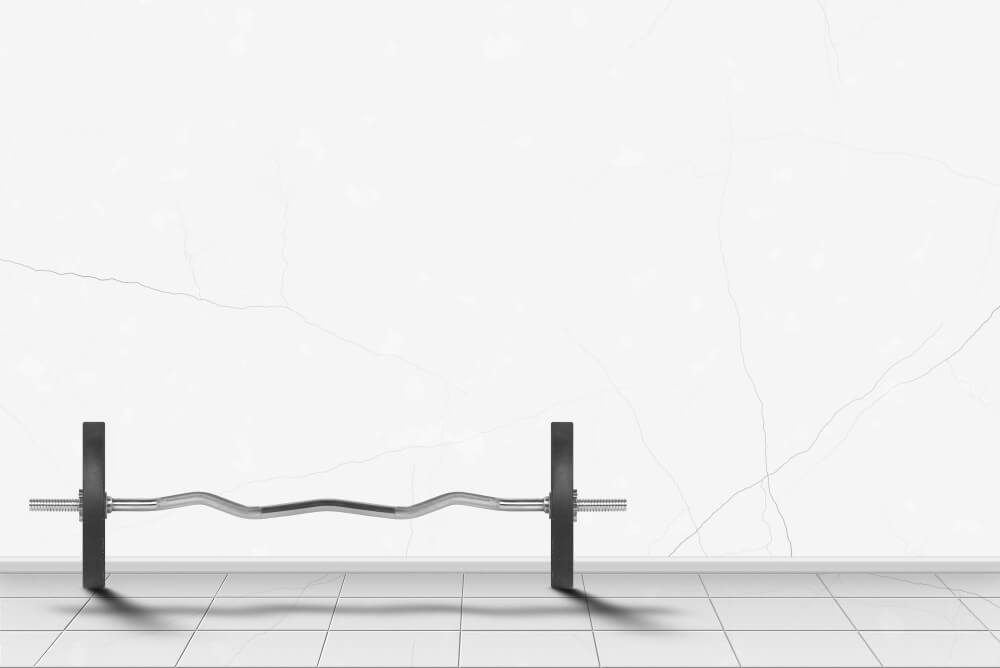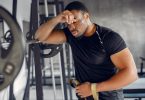Can I Use A Bent Barbell For Workout? Sure, you can use a bent barbell for your workout, but it’s not ideal.
Using a bent barbell is safe, but how safe is it? If at all possible, I’d steer clear of using barbells that have been bent. Because when they bend, they’re more likely to snap at a critical moment and injure you, as well as cause pain and discomfort during certain movements.
To a certain extent, it all comes down to the severity of the bend, the manner in which it is bent, and what you intend to do with the barbell. A new barbell is always the better choice, even cheap barbells are available.
Workouts performed with a barbell serve as the basis of many muscle-building, resistance training, and even general fitness exercises. A straight bar is the most popular kind of barbell you’ll easily come across out there, however most fitness centers stock a variety of barbells with varying shapes.
Therefore, in this article, we’ll review all you need about using a bent barbell for your workout exercises.
Exactly, How Does a Barbell Bend to Begin With
You can bend a bar in one of two ways: by lifting extremely heavy weights, or by dropping it precisely into the desired position. If you’re just a little bit careful with your equipment, you should be fine if you bend a barbell.
-
Bending a Barbell: How Much Weight Is Required?
Seeing a bent barbell immediately made me wonder, “Who on earth has the strength to bend a barbell?” Because I was aware that it takes a significant amount of weight to bend a barbell, I began digging to see what I could uncover. What a surprise! I may have picked up a barbell that was used by a famous powerlifter.
I regret to say that I was mistaken. The more I looked into it, the more I realized that lifting heavy weight had not bent my barbell or any other barbell. Hundreds of tests have shown that even the cheapest, lowest-quality barbells are capable of supporting 1,500 lbs.
Deadlifting 1,104.52 pounds and squatting 1,306 pounds are world records, so it’s clear that 99.9% of bent barbells were not damaged during the lifting process.
-
Dropping a Barbell can bend it
Barbells, on the other hand, are far more likely to bend when dropped. The bar is lowered, but the plates do not make initial contact with the ground as is customary. Squats and bench presses are two examples of lifts in which a bar hits the squat bar rack’s pins.
There is no need for a lot of weight, just around 300 pounds for the cheapest bars. Drops of up to 1000 pounds have been able to survive on high-quality bars.
Can You Use a Bent Barbell To Workout?

You should avoid using a bent barbell, if at all possible, but if you do not have the funds to buy a new one right now (that’s if your straight barbell has bent due to overuse), you can continue to use the bent one.
However, the result varies according to the location of the bend, the degree to which it is bent, and the workouts that you intend to perform with it.
Even performing the simplest of lifts with a barbell that is uneven on one side poses a significant risk to the user’s safety.
There will be an imbalance in the distribution of weight, which can result in significant injury. You can certainly use the barbell even if there are no weight plates attached to it.
The bend can also have an effect on the rotation of the pin, which could possibly cause the barbell to break. However, if the bend is not particularly sharp and it is located in the middle, the distribution of the weight should be excellent.
You should still steer clear of any workouts that involve endurance and instead focus on fundamental movements such as deadlifts or squats.
If you’re doing squats or sumo deadlifts, the bent side should always face up. In my experience, scoring the surface with a metal plate or tool is the best way to identify the side that should be facing upwards.
Putting the bar bent side up prevents it from shifting in your hands, which could lead to a fall and further bending or even worse, an injury.
However, even those activities might cause discomfort and lead to damage, so you should try to avoid using the barbell altogether and a suitable replacement.
How to Lift With a Bent Barbell
Grab the barbell at the point where it is bent. This is the most important step. This is due to the fact that the barbell will always rotate back to the upright position after being bent.
It is possible for this to become a very dangerous situation when you are performing workouts such as bench presses since the bar will rotate in your hand. Therefore, you should always keep this in mind.
You should be able to use the barbell for the majority of exercises, including squats, deadlifts, overhead presses, and so on if the barbell is slightly bent and there are no rolling pins on the barbell.
Do not attempt to lift something that is overly heavy with the bent barbell. In order to err on the side of caution, performing a higher number of reps is the preferred course of action instead of adding more weights
Can a bent Barbell Be Straightened?

It’s difficult, time-consuming, and expensive to repair a bent barbell. It is nearly impossible to replace the bearings, but you can at least clean and lubricate them. In order to straighten it, you’ll need a press.
To straighten a barbell, it must first be heated to a certain temperature and then hammered with a metal press.
Even if the barbell is “fixed,” it will never be the same again because its structural integrity has been compromised. You should not use a barbell if you cannot see the bend any longer with your naked eye.
Therefore, selling the barbell to someone who is willing to fix it and replace it with a better, brand-new one is a much better idea. Consider purchasing a barbell that can hold more weight than you are able to lift as a side note, as well.
Ways to Prevent a Barbell Bending
To avoid your barbell bending, all you need to do is take care not to drop it so that it hits the bar first. To be on the safe side, it’s always better to drop the bar than get hurt, so investing in a good bar that can withstand some punishment is always a good idea.
To ensure that your new barbell lasts as long as possible, here are some helpful hints to keep in mind:
-
Quality and Longevity of the Construction
When purchasing a barbell that is unlikely to bend, the quality of the construction is critical.
It’s a good idea to buy an iron barbell that can handle the weight of a failed squat or bench press. As a result, you must seek out barbells that are well-made and sturdy enough to withstand accidental drops.
Cheap barbells begin to bend when loaded with 300 pounds, while more expensive barbells can withstand thousands of pounds of weight. Are there any other factors at play? Tensile strength is the deciding factor in all of this.
To find out how much weight your barbell can support before snapping or cracking, look for the term “tensile strength” in the construction specifications for each one.
Barbells with tensile strengths under 150,000 should be avoided, while barbells with tensile strengths over 185,000 are recommended for serious lifters.
-
Training Method
Your training style can influence whether or not your barbell bends.
There are many factors to consider when selecting the right barbell for your workout routine. Powerlifters and bodybuilders do not require the more expensive barbells with rolling pins. Additionally, your training style has an impact on whether or not your bar will drop onto a rack or bend.
It’s not a problem for traditional weightlifters because they don’t work in a squat rack; as a result, when they drop the bar, the plates land first. Because bodybuilders work with lighter loads, bending a cheap bar is less likely.
Powerlifters, on the other hand, frequently lift heavy weights, which increases their risk of bending the bar. Because of this, you should purchase a high-quality bar if you are a serious powerlifter or train for competitions.
Differences between a curled bar and a straight barbell

This is a common question among sports enthusiasts who intend to incorporate as many workout equipment/ exercises as possible into their routine.
It’s important you know these differences to help you understand what’s specific to each of these barbells. We’ll now compare these contrasting barbells below in a number of criteria:
-
For Single–Joint Moves
When performing isolated exercises such as bicep curls or triceps extension, many personal trainers believe that using a straight bar places a significant amount of strain on the wrists.
Because you are able to adjust the angle at which your wrists are bent while using the EZ barbell, the workout will feel more comfortable and natural to you. So, the bent barbell is more ideal for single-joint movements than the straight barbell
-
For Bench Presses
There is no better bar for bench pressing than a straight bar. Wrist stability and balance are critical for maximizing your benching performance, and this is where a straight bar pulls ahead. Curled bars are also more prone to twisting, increasing the chance of slipping off during reps.
-
Multi-Joint Moves
Multi-joint isolation movements present a different issue. When it comes to squats, deadlifts, and other multi-joint exercises like rows and barbell lunges, the straight bar comes out on top every time.
It is far more sturdy, and as a result, it is safer to use. It would be an unpleasant experience to perform a variation of the squat and lunge that involved resting a curled bar across your shoulders.
The one advantage to this is that those just starting out with deadlifting might do better using an EZ bar. The curl that is found in the EZ barbell gives you the ability to hold the weight close to your body without causing any damage to your shins.
-
Size and Convenience
If you are working out at home but have a restricted amount of space, the EZ bar is the best option. The length and weight of EZ bars can vary depending on the manufacturer, but they typically range from 3 to 4 feet in length and 15 to 25 pounds in weight.
In comparison, standard Olympic bars measure 7 feet in length and weigh 45 pounds. Because of its lower overall weight, the EZ bar is an excellent option for beginning lifters who might have trouble moving 45 pounds.
Final Thoughts On Using Bent Barbell For Workout
In the gym, weightlifting equipment frequently suffers physical abuse. There are a number of factors that can lead to the deformation of a barbell over time, including heavy weights being dropped, banging and clattering on the rack/pin, and the barbell being slammed against it.
It’s up to you whether to replace the barbell with a better-quality model or to continue using the bent barbell. When lifting heavy weight, you should avoid using damaged equipment because of safety and injury concerns, but this will depend on how bent the bar is.
There should be no problem with a minor bend if the bend is in the middle of the bar, but excessive bends should be a red flag and should be replaced.







